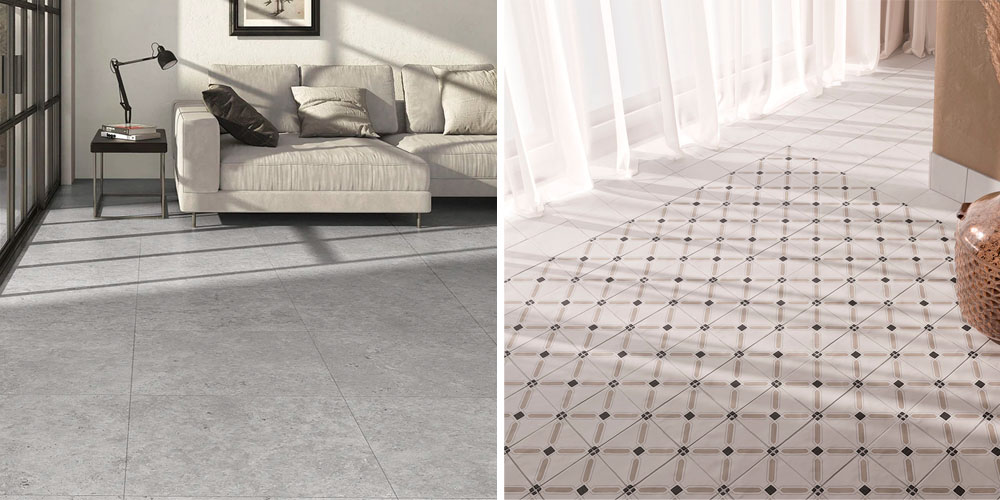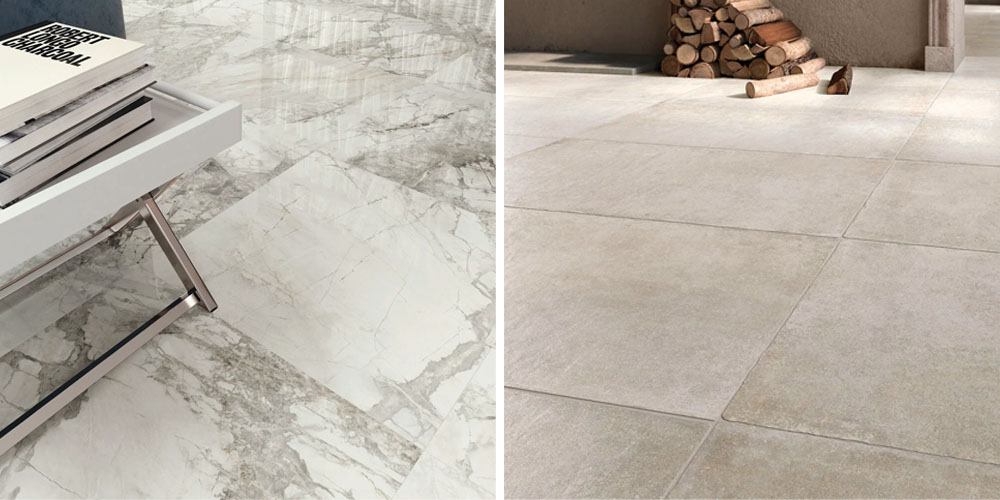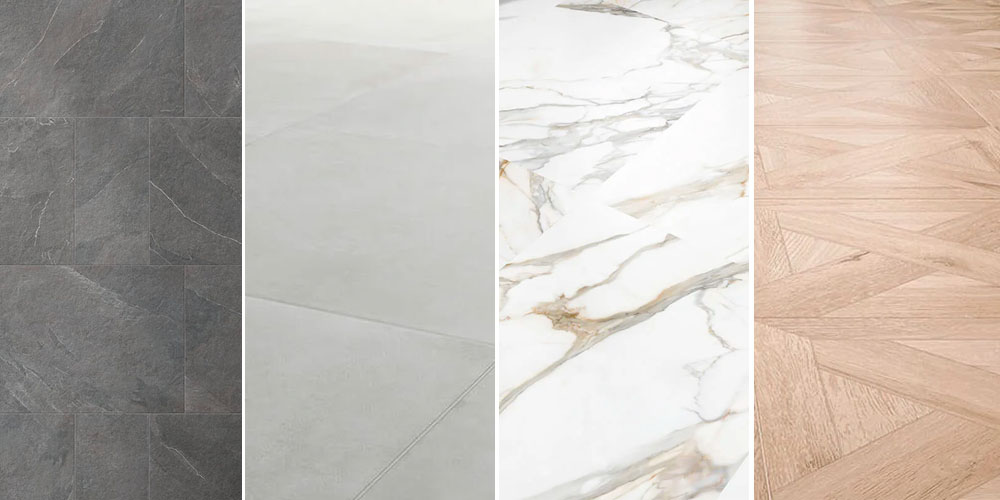If you’ve recently started looking into different tiling options because you’ve been thinking about adding tiling to your own home, you’ve probably come across two main types that people use – natural stone tiles and porcelain tiles.
And while natural stone tiles are an excellent choice for anyone wanting to add a set of tiles to their home, when it comes to the most popular tile material in use today, you need look no further than porcelain.
Over the last five years, porcelain tiles have grown to take the major share of the UK tile market. Developments in high-definition printing and production technology have enabled the expansion of porcelain tile designs, finishes, and sizes, giving you near-endless choices when creating bathroom and kitchen designs.
So, to help you decide if these tiles are right for you, we’re going to explain what a porcelain tile is, the advantages and disadvantages of porcelain tiles, and the different porcelain tile textures and finishes you can get at Stone Superstore.

Left: Roman Grigio Stone Effect Porcelain Tiles, Right: Wentworth Cross Patterned Tiles
What are porcelain tiles made of?
Made from layers of clay that have been fired in a kiln; at first glance, a porcelain tile might appear no different to a traditional ceramic tile. However, there’s more that goes into creating a porcelain tile than first meets the eye to give it its distinctive hardened properties.
Specifically, porcelain tiles are made from a far denser clay than standard ceramics and are fired at higher temperatures for much longer. This hardens porcelain to the point where it becomes highly durable, rivalling natural stone in hardness and completely surpassing ceramic in terms of strength and fragility.
How big are porcelain tiles?
The size of our porcelain tiles varies, depending on the style you choose. For instance, we have specifically large-format porcelain tiles, which range from square 1200x1200mm to rectangular 600x300mm, while our other selections are available between 330x330mm and 125x125 sizes. Meanwhile, if you are asking yourself ‘how thick are porcelain tiles?’, most of our porcelain tiles have a depth of approximately 9mm with only a small amount coming in slightly thicker or thinner.
The pros and cons of porcelain tiles
Naturally, much like any type of surface material, porcelain comes with a selection of advantages and disadvantages that you should be aware of before settling on this type of material for your tiling project.
What are the advantages of porcelain tiles?
For those looking to use porcelain tiles in their home, the good news is that they have several advantages that make them well-suited for use in various rooms throughout your home. These advantages include:
- High durability: As with stone tiles, porcelain is highly durable, being both long-lasting and resistant to scratches and stains. This makes porcelain the ideal choice for high foot traffic areas in your home that also see a lot of mess, such as kitchens.
- A wide style range: Thanks to the nature of its construction, porcelain can be styled to mimic a variety of other stone types, as well as numerous colours, shades, and textures, giving you the variety you need to find the perfect aesthetic to match your needs.
- Low maintenance: All porcelain tiles are quick and easy to clean, regardless of the stains in question. Their smooth surface prevents dirt from getting stuck, and as they’re automatically waterproofed during construction, there is no risk of unsightly marks being absorbed into your flooring.
What are the disadvantages of porcelain tiles?
Of course, with any selection of advantages also comes a couple of drawbacks, some of which may very well make a set of porcelain tiles less feasible for use in your home. These disadvantages of porcelain tiles include:
- Weight: Although normal ceramics are rather lightweight, the opposite is true for porcelain tiles. Due to how they are made and their increased density, porcelain tiles can be difficult to move and install without help. Due to their weight, a strong adhesive must be used, if they are being used as wall tiles.
- Price: While certainly the most popular tile choice currently on the market, it doesn’t necessarily mean that porcelain is a cheap option. As a result, if you plan on using porcelain in your home redesign, you need to be sure you have space in your budget to account for their price. However, the quality and endurance of porcelain tiles is un-matched, making them well worth their price tag.
- Prone to cracks: Porcelain might be one of the most durable tile materials you can choose from, but that doesn’t mean it’s indestructible. If accidentally dropped or hit by heavy objects, there is a very real chance that it can crack, and this damage can be hard to repair without replacing the tile in its entirety. Fortunately, if you do notice any small-scale scuffs, you can check out our guide to fixing scratched tiles.

Left: Marmo Venatino Polished Porcelain Tiles, Right: Lulworth Bianco Antique Effect Porcelain
What are the different types of porcelain tile finishes?
If you’ve still enthusiastic about using porcelain tiles for your kitchen or bathroom, let’s now touch on the different porcelain tile finishes we have available to add that finishing touch to their design:
- Matt: A matt finish occurs when tiles are buffed just enough to provide a dull sheen, letting you have distinctly coloured tiles without an overpowering reflection. Matt porcelain tiles offer the widest colour selection when it comes to finishes.
- Semi-polished: The latest trend in contemporary design, this finish takes inspiration from the semi-polished nature of natural stone to deliver shiny porcelain tiles that are not so polished that they excessively reflect light.
- Polished: This shiny, mirror-like finish shows off modern printing and polishing techniques to perfection. A cost-effective solution for achieving grandeur and opulence, polished porcelain tiles can mimic numerous other tile materials without their associated costs and drawbacks.
What are the different types of porcelain tile effects?
As with porcelain tile finishes, here at Stone Superstore, we also offer porcelain tiles in numerous effects. Take a look at our most popular ones below:
- Stone Effect: These excellent value stone-effect porcelain tiles are a fantastic alternative to natural stone for achieving an authentic finish.
- Concrete Effect: This range of subtle design-led concrete-effect tiles offers a more minimalist look than traditional porcelain tiles and is a firm favourite of architects and interior designers working on contemporary and ultra-modern interiors.
- Marble Effect: Our fantastic marble-effect porcelain tile range uses the latest ultra hi-definition printing technology to create beautiful marble-effect tiles that look even better than the real thing once laid, all without the additional maintenance required by natural marble.
- Wood Effect: These wood-effect tiles capture the beauty of natural timber with the durability and ease of maintenance you expect from porcelain tiles, that look great in both modern and traditional spaces.
Our porcelain tiles come in a variety of finishes and popular effects from stone and concrete, to marble, wood and even terrazzo.
And there you have it - you now know what porcelain tiles are and the different finishes that are available to complete your home aesthetic.
If you do have any more questions regarding using porcelain tiles in your home, please don’t hesitate to get in touch. You can also find out more about this versatile material by browsing the rest of our tile advice guides, including how to lay porcelain tiles and how to maintain porcelain tiles.


